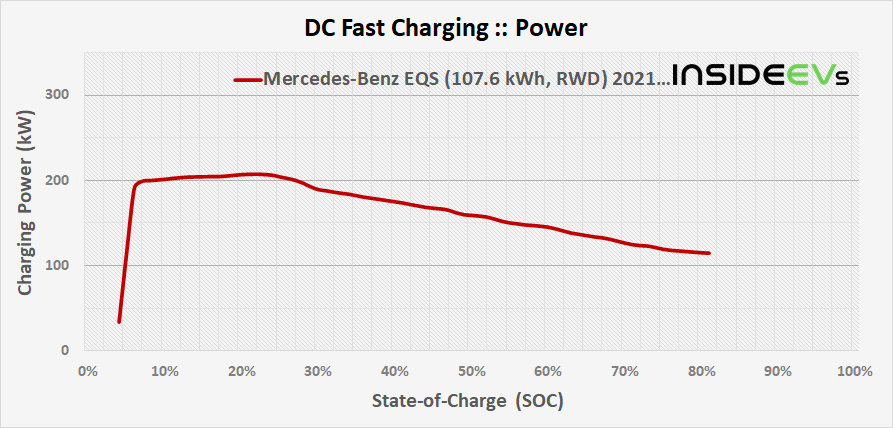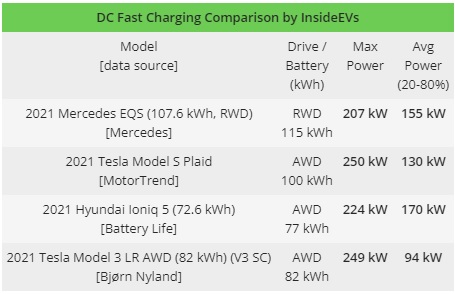Today we will take a closer look at the Mercedes-Benz EQS fast charging capabilities, recently exclusively revealed by the manufacturer in one of Autogefühl’s reviews.

The German flagship was expected to offer outstanding charging characteristics and after checking the numbers, we are not disappointed.
Let’s first see the chart from the video (4:45), which shows the power output and state-of-charge versus time. We had to combine those curves into power vs state-of-charge.

We assume that this is the chart for the 107.8 kWh battery version (usable capacity). There will be also a smaller 90 kWh battery version.
Charging power vs state-of-charge (SOC)
According to the chart, the peak charging power is almost 207 kW, which is a little bit more than in the specs (up to 200 kW).
Starting at around 4-5% SOC, power very quickly increases to the peak level and remains flat at up to over 25% SOC. Then the power decreases gently to about 115 kW at 80% SOC, which is really a very nice charging curve. The data ends after 80-81% SOC.

State-of-charge (SOC) vs time
Mercedes-Benz says that 10-80% charging will take 31 minutes and that up to 280-300 km (174-186 miles) of WLTP range can be replenished in just 15 minutes.
In the example charging curve, we noted even better results, as the 10-80% SOC took about 28 minutes, while 20-80% about 25 minutes. The entire session (about 4-81%) took about 31 minutes.
The chart below is only for illustrative purposes:

Average charging power vs state-of-charge (SOC)
The average power in the very important range from 20% to 80% SOC is 155 kW, which is 75% of the peak value.
Those are very good numbers, but the best thing is how consistent the charging is over the entire session:

C-rate vs state-of-charge (SOC)
The peak C-rate* – charging power in relation to the total battery capacity of 115 kWh (our guess) – is about 1.8C. We think that Mercedes-Benz rather not pushes its batteries to the limits (like 3C), but 1.8C is still a solid value.
The average C-rate when charging from 20% to 80% SOC is 1.35C.
*C-rate tells us how the charging power relates to the battery pack capacity. For example: 1C is 1-hour charging power (current), when the power value in kW is equal to the battery pack capacity in kWh. 2C would be enough to recharge in half an hour.
The net battery capacity of 107.8 kWh stands for about 94% of the total battery capacity (if our guess about 115 kWh is correct).

Range replenishing speed vs state-of-charge (SOC)
The rate of range replenishing depends on the energy consumption and the energy consumption depends on the use case.
In the case of Mercedes-Benz EQS, we have only the maximum WLTP range of 770 km (479 miles), which we assume is for the EQS 450+ rear-wheel-drive version. The all-wheel-drive EQS 580 4MATIC supposedly will have a lower range.
– WLTP
Taking into consideration the WLTP range of 770 km (479 miles) and available battery capacity of 107.8 kWh, we can assume energy consumption of 140 Wh/km (225 Wh/mile).
The effective average speed of range replenishing when charging from 20% to 80% SOC would be 18.5 km/minute (11.5 miles/minute).
Thanks to a high range and efficiency, as well as solid 200 kW charging peak, the EQS achieves an amazing rate of range replenishing of up to nearly 25 km/min (15.5 miles/min). The 20-80% SOC average of 18.5 km/min (11.5 miles/min) is also outstanding. Those are very good results, comparable with the best EVs on the market.

Ultimate DC fast charging card
Here is our ultimate charging card for the Mercedes-Benz EQS 2021 (Mercedes’s demo) that shows an estimated time of charging to add a certain number of SOC percent points, average charging power, added energy and added range for listed SOC ranges.

The matrix above, might be helpful from the user perspective, but be aware that it’s just an estimate from a particular test, with measure and calculation uncertainty probably above 5%. On top of that comes variation for individual case – car (version, age/battery state-of-health), charger, ambient and battery temperature, software version and more (including cabin heating/cooling during charging). Another thing is that the charging curve might shift when charging starts at a lower/higher SOC.
Comparisons with other EVs
In the next part we will compare the Mercedes-Benz EQS with a few other, recently analyzed EVs:
Comparison of charging power
When we compare the charging curves, we can notice that the EQS does not offer as high peak values as Teslas, or even Hyundai Ioniq 5, but it’s more stable. There is no radical decrease in power level at higher SOC.

The Mercedes-Benz EQS with an average of 155 kW beats Tesla Model S Plaid, and is not far behind the Hyundai Ioniq 5
However, to be honest – with the largest battery of the four, it could be higher.

Comparison of State-of-charge (SOC) vs time
Charging from 20-80% SOC in 25 minutes is a good result (the manufacturer promises 10-80% in 31 minutes, while the chart indicates rather 28 minutes). That’s slightly quicker than in the case of the Tesla Model S Plaid but way longer than in the case of the Hyundai Ioniq 5.

Comparison of C-rate
The Mercedes-Benz EQS stands out from the pack in terms of the C-rate, which is noticeably lower than in Teslas and Hyundai.
We guess that the German manufacturer is very conservative and doesn’t want to put too much strain on the battery (we saw this policy also in other premium German brands).

Anyway, the numbers look good and the average 20-80% SOC is even a bit higher than in the case of Tesla Model S Plaid:

Comparison of range replenishing speed
Finally, the range replenishing rate. The Mercedes-Benz EQS looks very strong in this comparison, thanks to its long range and high efficiency.

As we can see in the table, the average for 20-80% SOC window is almost as good as in the Hyundai Ioniq 5.
Moreover, due to the high difference in charging power, in the 10-80% the EQS beats the Ioniq 5 by 19.1 to 19.0 km/min! Tesla Model S Plaid would be closer to 15.3 km/min.

* Tesla Model S Plaid numbers were calculated using the estimated range of 637 km (396 miles), shown in the German online design studio.
Conclusions
The DC fast charging demo chart indicates that the Mercedes-Benz EQS is a really strong contender.
It does not offer the highest peak values, but the maximum power level is available for a substantial amount of time and then, the power decreases very slowly, maintaining 115 kW at 80% SOC. It translates to high average power levels and does not forces driver to target low state-of-charge to maximize charging speed.
Thanks to a high WLTP range and great efficiency, the car notes second-highest range replenishing rates, after the Hyundai Ioniq 5 (at least in the 20-80% range, because 10-90% might be very similar).
The only drawback of the EQS is that considering its battery pack capacity (roughly 50% bigger than in the Hyundai Ioniq 5), it should do even better. We can assume that Mercedes-Benz will improve the results even more in the future – the first attempt probably was conservative.

General info:
* Some values on the charts are estimated from the data source.
** Temperature of the battery cells might highly negatively affect charging capabilities. We don’t have data about temperatures of the battery at the beginning and during the charging process. In cold or hot weather, as well as after driving very dynamically, charging power might be significantly lower than shown on the charts (in extreme cases charging might be impossible until the battery temperature will not return to an acceptable level).
Mercedes-Benz EQS spces:
– up to 770 km (479 miles) of WLTP range
– two battery versions:
107.8 kWh of usable battery capacity (12 modules, about 9 kWh each)
90 kWh of usable battery capacity (10 modules)
CATL lithium-ion cells (pouch cells or hard-case/prismatic cells), NCM 811 chemistry
400-volt architecture (396 V nominal)
– 0-100 km/h (62 mph):
EQS 450+ RWD: 6.2 seconds
EQS 580 4MATIC AWD: 4.3 seconds
– top speed of 210 km/h (131 mph)
– powertrain options:
EQS 450+ rear-wheel drive (single motor): 245 kW and 568 Nm
EQS 580 4MATIC all-wheel drive (dual motor): 385 kW (255 kW rear and 135 kW front) and 855 Nm
performance version: 560 kW in the future
both motors are permanently excited synchronous motors (PSM)
peak regenerative brake up to 290 kW (580 4MATIC) or 186 kW (450+)
– AC charging (on-board): three-phase 11 kW standard and 22 kW option (Europe)
Charging time (107.8 kWh): 5 hours at 22 kW AC, 10 hours at 11 kW AC
– DC fast charging: up to 200 kW;
10-80% SOC in 31 minutes
up to 280-300 km (174-186 miles) of WLTP range to be replenished in just 15 minutes
Plug & Charge feature
– Length/width/height: 5216/1926/1512
Length/width/height (USA): 5265/1926/1513
– Cd value starting from 0.20 (EQS 450+); 0.209 (EQS 580 4MATIC)
– Boot capacity, VDA: 610-1770 L
– Weight in roadworthy condition: 2480 kg (EQS 450+); 2585 kg (EQS 580 4MATIC)
Payload: 465-545 kg (EQS 450+); 475-550 kg (EQS 580 4MATIC)
Perm. gross vehicle weight: 2945-3025 kg (EQS 450+); 3060-3135 (EQS 580 4MATIC)
– EVA platform
Mercedes-Benz EQS Charging Analysis Review
04/08/2021
No Comments
Mercedes-Benz | Mercedes-AMG
Click to rate this post
[Total: 2 Average: 5]